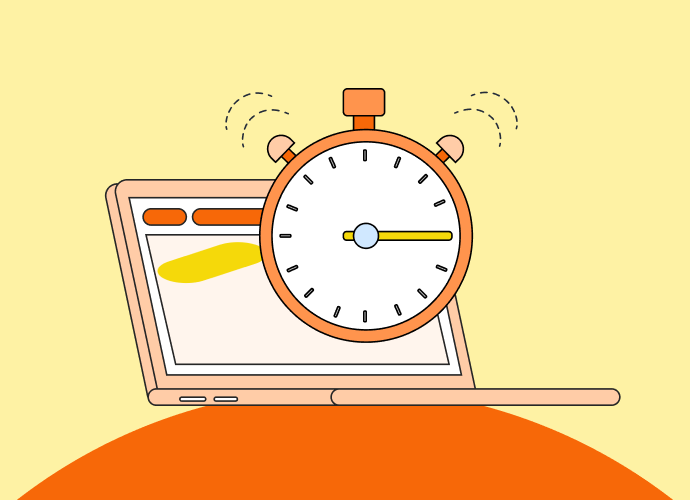Ideally, every task on your to-do list should take just the right time to complete. Yet, we've all been there: stuck in a three-hour meeting that should've wrapped up in 30 minutes or baffled by a two-day assignment taking an entire week to finish.
The solution to tasks spiraling out of control lies in a time management strategy called timeboxing. By assigning a specific time slot to each task, you can prevent overruns and burnout while staying on track and efficient.
In this article, we'll explore the ins and outs of timeboxing, explaining how it works and offering guidance on how to use it to manage both your time and your team's work. With just a few simple steps, you'll be well on your way to improving your productivity and workday!
What is the timeboxing method?
Timeboxing is a time management strategy that assigns a specific duration to an activity, expecting to produce a well-defined deliverable at the end of that period.
Often utilized in agile project management, timeboxing helps ensure that each sprint remains focused and productive by allotting a fixed time limit for completing every task or activity within the sprint.
Some common examples of timeboxed events include sprint planning, daily standups, and sprint retrospectives. For personal time management, a popular example is the 25-minute Pomodoro Technique.
Whether you're implementing timeboxing for personal or team productivity, three essential elements must be present: a set time frame, a clear goal, and a specific deliverable.
Finishing all the necessary work within the allocated time frame is crucial. If the task isn't completed, it should be carried over into another time box, as practiced in the Pomodoro method, instead of extending the current one.
➡️ Learn more about the Pomodoro Technique.
Types of timeboxes
There are two primary types of timeboxes: soft and hard timeboxes. Soft timeboxes provide a gentle nudge to wrap up the task at hand before moving on to the next one, much like when a meeting timer goes off. The alarm serves as a reminder to promptly bring your task to a close.
In contrast, rigid time boxes require you to switch to the next task immediately, regardless of whether the current one is completed. This approach ensures that assignments or discussions don't drag on for too long, boosting productivity.
Does timeboxing work?
By dedicating time solely to one task, timeboxing eliminates distractions and reduces the time needed to complete tasks. Here's how timeboxing contributes to better productivity:
- Increases motivation: According to the temporal motivation theory, time significantly influences motivation. For instance, a student with an exam in two weeks will naturally increase their study hours, setting aside distractions in pursuit of a more important goal—passing the exam. Similarly, timeboxing creates a sense of urgency and increases motivation to complete the task.
- Eliminates multitasking: Studies show that multitasking reduces our ability to focus and learn. Neuropsychologist Cynthia Kubu explains, "If we're constantly attempting to multitask, we don't practice tuning out the rest of the world to engage in deeper processing and learning." Timeboxing strengthens the brain's ability to process information by focusing on one task at a time.
- Improves focus and supports deep work: It takes an average of 9.5 minutes to re-engage with a task after context switching, and we often carry ideas from one task to another. Timeboxing minimizes interruptions and supports intense focus and deep work. This state of flow makes it easier to solve problems and generate ideas.
- Negates Parkinson's law: Parkinson's law states that work expands to fill the time allocated. Timeboxing limits task durations and ensures that the minimum time is spent completing it.
- Avoids the planning fallacy: The planning fallacy refers to our tendency to underestimate the time needed to complete tasks. Timeboxing assists in planning time accurately and avoids scheduling problems.
<tip>
Pro tip
Track actual hours and compare with Float estimates to optimize timeboxing and improve time management.
<tip-button>Learn more</tip-button>
</tip>
How does timeboxing differ from time blocking?
It's easy to confuse timeboxing with time blocking, as both involve managing your schedule to maximize productivity. However, there's a subtle but essential difference between the two techniques.
Timeboxing is primarily about setting limits on the time spent on tasks. With this approach, you allocate a fixed period to work on a specific task, ensuring that it doesn't drag on longer than necessary.
On the other hand, time blocking is about protecting and dedicating time to specific activities. When you use time blocking, you focus on keeping distractions at bay and reserving a block of time for particular tasks or groups of tasks.
In essence, timeboxing is about managing the duration of tasks, while time blocking is about preserving dedicated time for those tasks. Both techniques can be helpful in different situations, and you might even find that a combination of the two works best for your productivity needs.
How to timebox
Timeboxing is a powerful technique to improve team productivity and ensure tasks are completed within a set time frame. Here's a step-by-step guide to implementing timeboxing effectively:
1. Planning
During the planning stage, there are three important questions to consider: What needs to be done? How long will it take? What is the expected outcome? Your answers will help you create appropriate timeboxes.
If you're timeboxing project tasks, refer to your work breakdown structure or project list to determine the necessary tasks. For personal tasks, refer to your to-do lists.
It's crucial to set a clear outcome or deliverable for each time box so that every task contributes to achieving a higher goal.
➡️ Learn how to break down tasks with the GTD method.
2. Estimation
Once you've identified the necessary tasks, estimate how long each task will take and assign a fixed period or deadline for completion. Keep in mind that initial estimates might be affected by the planning fallacy.
When collaborating with a team, it's helpful to base time estimates on data from previous projects. Using a resource management tool like Float, you can easily compare a team member's planned hours with their actual logged hours to forecast future project timelines more accurately.
By comparing the total logged percentage of a budget with the total scheduled percentage, you can better understand the differences between estimated and actual timelines. Understanding these discrepancies helps you make more informed decisions about resource allocation and time management for future projects.
You can also speak with those involved in the project to determine how long tasks will take. It's important to be prepared to adjust these estimates until a reliable time frame is established.
3. Execution
Begin to work on the determined activities. It’s helpful to track how much time has been spent on each task and how much time is remaining. Teams can set deadlines in a project management tool, while individuals can use timers or stopwatches for personal tasks.
<sme-box><sme-color="blue">
<sme-image>

</sme-image>
<sme-author>Colin Ross</sme-author>
<sme-position>Director of Engineering at Float</sme-position>
<sme-quotes>
"Finding what the right length is is tricky and depends on several factors:
- How quickly the team can make changes
- How flexible the team wants/needs to be to changing objectives
- Any external factors that might dictate a cadence
- Overall confidence in the team's ability to deliver and what people are used to.
Often it's more about getting into a rhythm more than anything else—people start to be more familiar with how long things might take in terms of cycles if the cycle length remains consistent, and the team can begin to build up that body of experience."</sme-quotes>
</sme-box>
Analysis
At the end of a timebox, review your progress. Did you complete the task within the allotted time frame? If not, identify any obstacles or delays. If a task took longer than expected, adjust the time frame or allocate additional resources as needed.
Drawbacks of timeboxing
While timeboxing is very effective, it does have some drawbacks that might make it less suitable for specific individuals or teams.
Disrupting flow
Timeboxing can support entering a flow state, but the timer's alarm often interrupts this state. Such disruptions can be frustrating and hinder progress. As Zoë Read-Bivens describes her experience with the Pomodoro Technique, a form of timeboxing, "I'm piecing together concepts, and I feel like I'm in a different world, and then with a pleasant jingle, I am WRENCHED out of my flow state. Again the frustration."
Difficulty estimating time accurately
Timeboxing relies on the accurate estimation of task durations. If these estimates are off and a task takes longer than anticipated, it can disrupt your entire day or throw your project off course. For instance, laying the foundation of a building might take two weeks, but rainy weather could cause unexpected delays.
Compromised quality
To meet timeboxing deadlines, some teams may rush through tasks or cut corners.
For example, in a software development project, a team may skip some testing or code review steps to deliver the product on time. This can lead to bugs or issues that may affect the user experience.
Manage your team's time with Float
Timeboxing is a powerful strategy to help individuals and teams manage their time, enhance focus, and successfully achieve their project goals.
By leveraging a project planning tool like Float, you can effortlessly incorporate timeboxing into your routine and experience the advantages of increased productivity and superior project outcomes.
Float's intuitive time-tracking features enable you to monitor your team's progress seamlessly, keep tabs on time spent on each task, and adjust time frames as necessary. This ensures your team stays on track and avoids burnout while consistently meeting deadlines.
Give Float a try for free and experience the difference it can make in your team's time management today!
<cta-box>
<image-color="yellow">
Track your team's time with the #1 project planning tool
Improve time estimates and get valuable insights into task durations by tracking time in Float.
<cta-button>Try for free</cta-button>
</cta-box>








